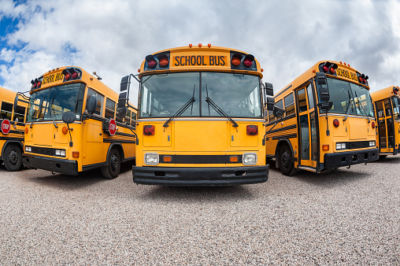


As the 2017 school year gets into full swing, parents have fallen back into the habit of escorting their children to the bus stop for school. But is that school bus safe? A recent Michigan State Police report breaks down school bus safety by the district, putting you in the driver's seat of your child's safety.
Anyone who rode a bus to school probably remembers the high-backed seats with no seat belts and seemingly horrible suspension. The enclosed chaos of a school bus may seem risky, but in fact, a student on a school bus is far safer than in a car.
The National Highway Traffic Safety Administration (NHTSA) calls the school bus the safest vehicle on the road. Four to six school-age children die in school bus accidents each year. But that makes up less than 1% of all traffic fatalities. Students are 70 times more likely to get to school safely on a school bus than in their parents' cars.
Many factors contribute to school buses' safety. The NHTSA's Federal Motor Vehicle Safety Standards make school buses the most highly regulated vehicles on the road. They are designed to be highly visible and include safety features like flashing lights, cross-view mirrors, and stop-sign arms. Full-sized school buses also use "compartmentalization" — high-backed, closely-spaced, energy-absorbing seating that protects children without the need for seat belts.
The law also sets up barriers to protect students and prevent school bus accidents. School bus drivers are required to maintain commercial drivers' licenses which ensures a safe driving history. Other drivers on the road are also required to brake for a stopped school bus. It is illegal to pass a school bus while it is dropping off or picking up passengers. This protects students from pedestrian accidents immediately before or after riding the bus.
The Michigan State Police (MSP) are responsible for enforcing these laws and regulations on a state level. MSP reports, "Michigan has approximately 17,000 vehicles that transport in excess of 800,000 children over 10 million miles annually." Its Commercial Vehicle Enforcement Division (CVED) performs annual inspections of every black and yellow school bus and other student transportation vehicle used by public, private, parochial, and charter schools across the state. Upon inspection a school bus can be rated:
At the start of each school year, the MSP publishes its School Bus Inspection Report for the school year. The report summarizes the ratings given to the buses of each school district in the state. From September 1, 2016 to August 31, 2017, the Michigan State Police inspected 16,122 buses. It passed 13,162 vehicles, issued yellow warnings for 878 buses, and tagged 2,082 school buses red.
The report covers everything from the 348 buses of the Detroit City School District to the single bus operated by Pioneer Resources - Muskegon. Want to know how your school district measures up? You can download the entire report on the Michigan State Police website.
School bus accidents can be tragic and can severely injure children. But the tight safety regulations and regular inspections are designed to that risk to a minimum. At Sachs Waldman, our extensive experience includes helping injured pupils after a school bus accident. We can help you recover auto insurance benefits and third-party negligence damages. Contact our Detroit personal injury law office at 1-800-638-6722.
© 2025 Michigan Injury Attorneys
View Our Disclaimer | Privacy Policy
Detroit Personal Injury & Car Accident Attorneys